Click Here if you listened. We’d love to know what you think. There is even a spot for feedback!
Read along below!
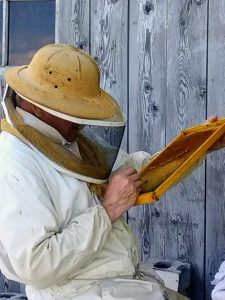 New(ish) Beekeeper Column
New(ish) Beekeeper Column
Chaos in the Beeyard
By: Richard Wahl
Orientation Flights
My bee hives are located on a cement pad on the south side of an old hip roof dairy barn. They are only about sixty yards south of my house and several other farm utility out buildings. This allows me to walk out and take a quick look at the hive entrances on any day I choose. Quite often, all I see is the normal coming and going of a few dozen forager bees with one or two standing guard at the reduced entrances. But every so often I catch a hive with a lot of activity, bees flying about, just to the front of the hive. These are called orientation flights and have certain distinguishing characteristics.
Orientation flights will usually occur on warm, sunny days. The bees use these flights to orient where their hive is located in relation to the position of the sun as well as other area structural and environmental features. They may involve a few dozen bees or several hundred flying about in a random pattern from directly in front of the hive out to a few dozen feet. Orientation flights last anywhere from ten to fifteen minutes up to an hour in length as bees circle, seeming to be looking back at the hive, in ever increasing figure eight arcs. Bees fly in a calm, deliberate manner as the flights extend farther from the hive.
These orientation flight bees will return to the hive several times without pollen, nectar, water or propolis before commencing their assigned forager activities. They may take anywhere from one or two up to a dozen or more orientation flights near the hive location before leaving on a forager flight. This might suggest there are different learning rates among the bees or that slight age differences come into play. If the hive has been disturbed or received a recent hive inspection, some bees could also be temporarily reassigned after orientation to previous clean-up or nurse bee duties depending on the needs of the hive. These bees would then repeat reorientation flights at a later time.
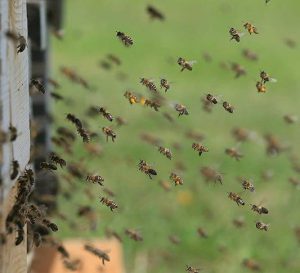
While some bees are orientating, other foragers are returning with pollen.
Most orientation flights occur with bees that have never before left the hive somewhere from two to three weeks after emergence from their birth cells. After spending their first few weeks completing clean-up and nurse bee duties, orientation flights prepare bees for the last few weeks of their lives as foragers. Since the queen can lay up to 1,500 eggs or more in a short period of time, pupae will emerge from those cells in a close sequential timeframe and will have matured for orientation flights around the same time. It is just another wonder of the bee environment as to how the bees select a particular time to complete orientation flights in small groups despite a slightly different cell emergence sequence and maturity of age.
Another reason for orientation flights is that the hive has been moved to a new location or that the hive is the result of a swarm that has recently found their new home. This is why it is recommended that a moved hive have a few pieces of brush or some other non-flight inhibiting object placed in front of the entrance to clue the bees into the need for new orientation flights to familiarize with the new location. If bees are moved less than three miles away from their previous site, any bees that had previously left the hive as foragers will return to the previous location and more than likely be lost.
Several of my swarm traps are only a hundred or so feet away from my production bee hives. When a swarm moves in, I transfer it into a ten frame deep hive located just below the swarm trap as soon as possible. That hive will remain there through the Summer and early Fall. I watch the weather and on a late Fall or early Winter evening, when night temperatures will remain above freezing after dark, I close the entrances and move the hive the day before rainy weather is set to move in. That way I know all bees have returned to the hive for the night and poor weather the next day means most will remain inside the hive. A few twigs or other obstructions set in front of the hive entrance results in the signal for new orientation flights. I have not found signs of any bees returning to the old location below the nearby swarm trap using this method.
Swarming Chaos
Bees that are preparing to swarm show different characteristics from those that are going through orientation flights. While the coming and going of bees from the hive for orientation appears much like the coming and going of foragers for necessary resource collection, bees leaving the hive as a swarm exit as fast as they can, often line abreast with as many as possible exiting the access opening. These bees have engorged themselves on available hive honey and nectar in order to survive what may be up to three or four days before finding a new home. The swarm will normally make their first rest stop forming as a cluster on some branch or object a few hundred feet from the hive, but may travel as far as three miles before landing as a cluster. While orientation flights are within a few yards of the hive, the initial swarm covers a much broader area and is much more chaotic until the queen leaves. The queen is normally one of the last to leave as she is not as strong a flyer as the other mostly forager bees. A swarm that is departing your apiary hive may just decide that a nearby swarm trap is the best place to set up new housekeeping. I once had an unused empty drawn comb hive sitting in the middle of a row of other active hives. To my surprise, one Summer day when inspecting other hives, I found that a swarm had moved into the vacant hive right in the middle of other hives not more than five or six feet apart.
A swarm that is forming will be made up of thousands of bees of at least half the hive population and will cover an area at least a dozen yards from the parent hive, erratically changing flight direction as they wait for the queen to depart. This type of departure from one of my hives five or six years ago took me by surprise and I was so mesmerized by the exit of so many bees so quickly that I simply watched in amazement. The bees, after only a few minutes, coalesced into a cloud not more than a few yards wide and departed to the south never to be seen again. My plan to split that hive was a day late and a dollar short, as the saying goes.
But every event in beekeeping has a lesson and I quickly took action this past year when I saw the same frantic action of bees exiting from a hive. A few weeks after I had split the hive three ways, I was inspecting one of its nearby spin-off nucleus hives (nucs) and saw an unmarked queen entering the nearby nuc. I chalked this up to a virgin queen returning from a mating flight since the timing from the split was about right. As I pulled a frame or two from the nuc for further inspection I noticed the neighboring parent hive begin to swarm. I quickly left the open nearby nuc and removed the second deep from the previously large split hive which was beginning to form a swarm of erratically flying bees. This must have disturbed the exit process as the previously marked queen from the swarming hive landed on the nuc hive bottom board. I quickly moved her back into the parent hive and soon had a cluster of potentially swarming bees that were now joining her.
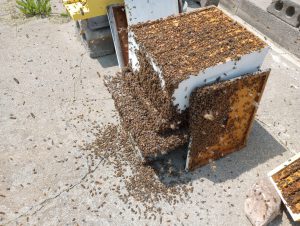
Once the queen was returned, the swarm reformed on this hive.
I once again split this hive that was attempting to swarm and by afternoon things settled down with a new virgin queen in the nearby nuc, this fourth split from the parent hive settled in with the original marked queen, and the original newly split hive portion needing to make another new queen. Had I not seen this as it occurred, I most likely would not have known the previously split hive had again swarmed, other than a new queen would have been present. In addition to over-crowding in a hive, the urge to procreate the continuation of the genetic line may be just as strong an enticement to swarm. I can only assume this was the case in this instance since that hive had previously been split three ways. This ended one of my most chaotic experiences in the beeyard. I would guess the whole “stop the swarm” adventure was over in less than fifteen minutes. The lesson learned here is that simply because you previously split a heavily populated hive does not preclude the hive from swarming again in the future.
Absconding Bees
The flight of bees that have decided to abscond from a hive is much the same as swarming. Although I have not seen absconding in action, I am aware of three instances where a hive had recently absconded. The difference between swarming and absconding is that all the bees in the hive leave rather than just a portion as occurs in swarming. To prepare for absconding the queen will stop laying eggs, foraging will stop, scout bees may be sent out to look for a new home as the queen is slimmed down for flight and the bees will engorge themselves on stored reserves before they depart the hive. A later hive inspection will find virtually no bees remaining and quite often a number of frames that previously held nectar or honey completely emptied out. Reasons for absconding could be any of the following. The newly installed package or swarm simply does not like their new home. This may be due to too much old drawn comb in the hive or the hive’s location. I was once verbally assisting a first year beekeeper but had not seen the location of his hive. Things seemed to be going well when in late June I received a call from him that he no longer had bees in his hive. At that point I made an on-site visit to inspect and found that his hive location was against a row of tall pine trees on the east side of his yard with the hive entrance facing west. The hive was not getting any sun until shortly after noon. He reported that all looked well a week or so before with honey stores in frame cells and, in his estimation, at least as many bees in the hive as when he had purchased them. Numerous empty cells, no brood or eggs present, only a half dozen bees in an upper frame corner and no evidence of disease or critter intrusion were instant clues the hive had absconded.
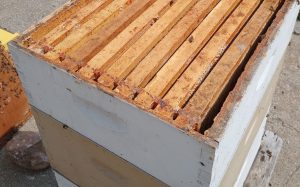
Once bees abscond, previous honey frames may be empty and almost no bees will remain in the hive.
In another instance, I had forced a very substantial number of bees that had resided in three deeps and several honey supers into two deeps in the late Fall. Sometime shortly after that in November, I found the hive empty, most honey stores gone and only a half dozen bees in an upper corner indicating the hive had absconded. This was most likely due to overcrowding them into two deeps. They probably did not survive the Winter leaving at that late a date. On the third occasion, as I reported in a recent issue, I was using my swarm vacuum to remove bees from a house wall. After four days of the vacuum running, with water and stores available in the capturing deep, it appeared all bees had decided to leave the house wall. I can only assume that since no foragers were returning to the swarm’s new location in the wall, the bees not already removed by the vacuum, also decided to abscond via the vacuum tube. A newly moved in swarm made up mostly of foragers relies on those foragers to provide new supplies for the new hive location. Without returning foragers the hive cannot survive and will need to choose to abscond or they will perish.
Robbing Flights
While orientation, swarming and absconding flights normally occur in short periods from late morning to mid-afternoon on warm sunny days, robbing can start as soon as the sun comes up as bees come out of the hive in the morning and will last well into the evening hours. Clusters of bees may be examining any outer cracks or crevices in the hive they are attempting to rob. A good way to tell robbing flights apart from the others is the attitude of the bees at the hive entrance. While bees performing orientation flights are coming and going freely, robbing is very chaotic with numerous tussles going on at the entrance. If you see bees clinging to each other in a fight like a wrestling match, appearing to try to sting each other, it is an indication of an attempt at robbing. There will be a lot of this chaotic movement going on between two or three bees in several different bunches. Naturally, the hive owner bees are trying to protect their stores while the robbers are trying to get to those resources.
During normal hive activity, you may see a bee or two struggling to carry out another dead bee. This is normal and simply a matter of the undertaker bees removing any dead bee bodies from the hive in a controlled manner. The dead bee is not fighting back. Also in the Fall, if you see larger bees being carried or dragged out of the hive this will be the drones getting evicted in preparation for Winter. Drones cannot sting and though they may struggle to return there is not the frenzy of a fight seen with robbing bees.
Another way to tell if robbing is occurring is to take a quick look at the screened or regular bottom board. If there are bits and pieces of wax comb uncapping littering either type of bottom board then robbing has or is happening. Robbing bees do not have the time to simply make a small hole in the capping to extract the needed honey and then recap it. Robbing bees will tear enough of the capping off to get to the honey, remove it and exit as quickly as they can. These torn capping remains can be easily seen when an unused frame of honey is set out for the bees to clean out. Any frames set out for bees to clean should be placed several hundred feet away from active hives to avoid starting a robbing frenzy.
Another method is to simply put clean-out frames in another super placed on top of the inner cover and below the outer cover. In this manner, only the hive owner bees can get to it and since it is above the inner cover central vent hole, it will normally not be considered part of the hive. It will get cleaned out without attracting yellow jackets, wasps or bees from other hives.
Bees are hard workers with the innate instinct to store up supplies for the Winter or seasons when pollen and nectar resources will be scarce, called a dearth. If a hive has a low population during a re-queening or is a new nuc or starter hive, a stronger hive may go into a robbing mode. This will particularly be true if there is a dearth going on with limited nectar resources available from the outside environment, which often happens in the Fall. A low population in a young colony with pest or disease problems may also make the weaker hive ripe for robbing.
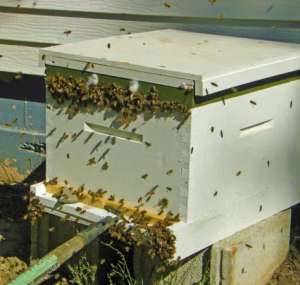
Bees will check any hive cracks for potential robbing. Notice the normal lower entrance has been closed off. Photo by Honey Bee Suite
Minimizing the entrance size on smaller hives or start-up nucs in the Spring and Summer allows fewer bees needed to guard their entrance and will often negate robbing by bees from other stronger hives. If a hive appears to be undergoing robbing it should be stopped as soon as possible. The robbing bees may be bringing in disease or pests as well as resources to their parent hive. If you notice robbing activity, use an entrance reducer or commercial robbing screen to curtail it. One technique used by some beekeepers I know is to use a towel to cover the remaining open area frames of a super as each frame is quickly inspected. This not only seems to help keep the inspected bees to remain more calm but also decreases the chance of setting off a robbing frenzy as bees can easily sense an open hive and may decide it is ripe for robbing. The tendency toward robbing can be greatly diminished by the vigilant beekeeper. Initiating a feeding regimen during early Spring, late Fall or a dearth can also reduce the probability of robbing.
Chaotic activity just outside the bee hive can be confusing and intimidating. Understanding some of the actions of bees, along with their comings and goings will aid in evaluating what all this activity means. My hope is that if you witness any of the aforementioned movements by bees you will have a better understanding for their reasons and the corrective action to be taken if needed. Your experience may vary depending on your conditions, environment or the state of your bee activity.






